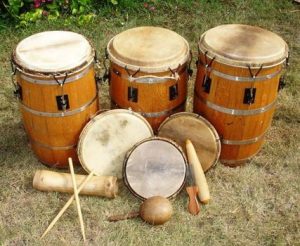Creolization Spanish- Speaking Caribbean
Spanish Colonization
With the arrival of Europeans in the Caribbean, a world history of great importance for both the Caribbean and Europe begins. One of the great colonial systems, the Spanish, which was the oldest and most extensive; was implanted as a result of the voyages of Christopher Columbus at the beginning of the 16th century.
In this century, the Spanish occupied the Greater Antilles
- Jamaica
- Hispaniola
- Cuba
- Puerto Rico
In the seventeenth century the other European powers, England occupied Jamaica and France occupied the western part of Hispaniola, remaining under Spanish domination:
- Cuba
- Puerto Rico
- Dominican Republic (eastern part of Hispaniola)
The Spanish conquistadors plundered the Indian populations of these countries and forced them to work as enslaved people, but from that moment begins the mixture of indigenous and Spanish cultures. After nearly exterminating the Indians, the Spanish brought slaves from Africa to do the jobs the Indians had done. By bringing the slaves to the Caribbean, the following cultural mixture is produced, which results in the cultural diversity of the Spanish-speaking Caribbean countries. Below we show two examples of creolization in these Caribbean islands.
1- Puerto Rico
In the article " Puerto Rico" Thompson, 2001 presents the instruments of Puerto Rico. Many of these instruments originating in Puerto Rico are percussion instruments and have been inherited from the culture of the Tainos.
The following figure shows some of the typical instruments of Puerto Rico, used in the Puerto Rican genres bomba and plena such as:
- Goat-skin barrel drums
- Buleador (low drum)
- Subidor or Primo (high drum)
- Maracas
- Cuá, or stick drum
- Guiro
- Tambourines
Bomba - Puerto Rico.
Bomba is both a traditional dance and musical style of Puerto Rico. Its origins are rooted in the island's history of African slavery. Bomba is a creative and interactive relationship between dancers, percussionists, and singers.
The oldest genre in Puerto Rico, almost 500 years ago, arrived in different regions such as Loíza, Santurce, Mayagüez y Ponce.
Its instruments are:
- Two barrels - African heritage
- Buleador drum - where the beats of the bomba are executed.
- There are about 19 styles but there are five that are the most popular in Puerto Rico
- Cousin or uploader drum - This drum marks the steps of the dancer or bailadora.
- One maraca - Taino heritage
- The cua that are the sticks - Taino heritage
The bomba also includes the dance - Spain heritage
- Piano
- Double bass
- Trumpets
- Guiro
- Kettledrums
References
Bell, L. (2017, August 4). Rumba in Cuba. Nationalgeographic.co.uk. https://static.nationalgeographic.co.uk/files/styles/image_3200/public/rumba-cuba-3.png.webp?w=710&h=471
BIS Music. (2015, March 5). Adalberto Álvarez y su Son - Y qué tú quieres que te den? (Video Oficial). Www.youtube.com. https://www.youtube.com/watch?v=24lHSU35Aqs
Daniel, Y. (1996). Rumba: dance and social change in contemporary Cuba. Indiana Univ. Press.
KQED Arts. (2020). Puerto Rico’s Bomba, A Dance of The African Diaspora | KQED Arts [YouTube Video]. On YouTube. https://www.youtube.com/watch?v=z0vzkGKEWX4
Renaissance of Bomba & Plena Part 2: Bomba Origins. (2018, August 31). Latino Music Cafe. https://latinomusiccafe.com/2018/08/31/renaissance-of-bomba-plena-part-2-bomba-origins/
Thompson, D. (2001). Puerto Rico. Oxford Music Online. https://doi.org/10.1093/gmo/9781561592630.article.41092



Comments
Post a Comment